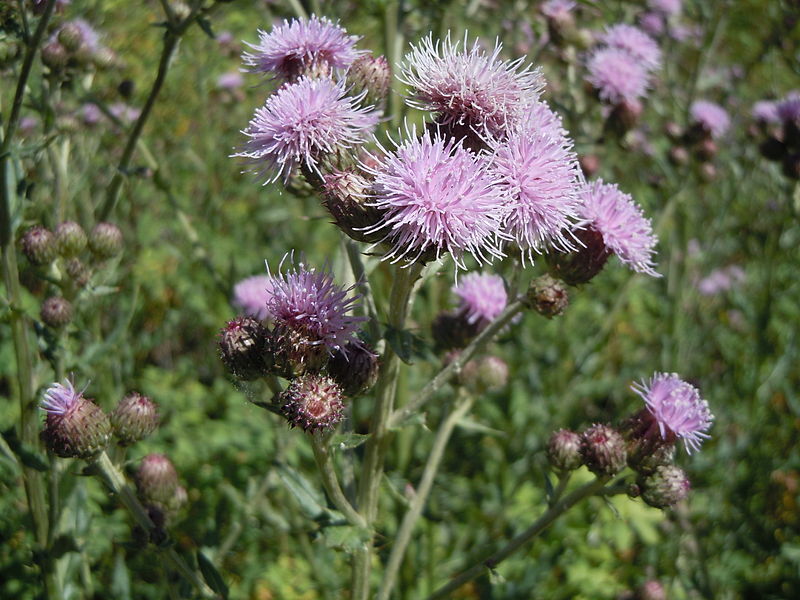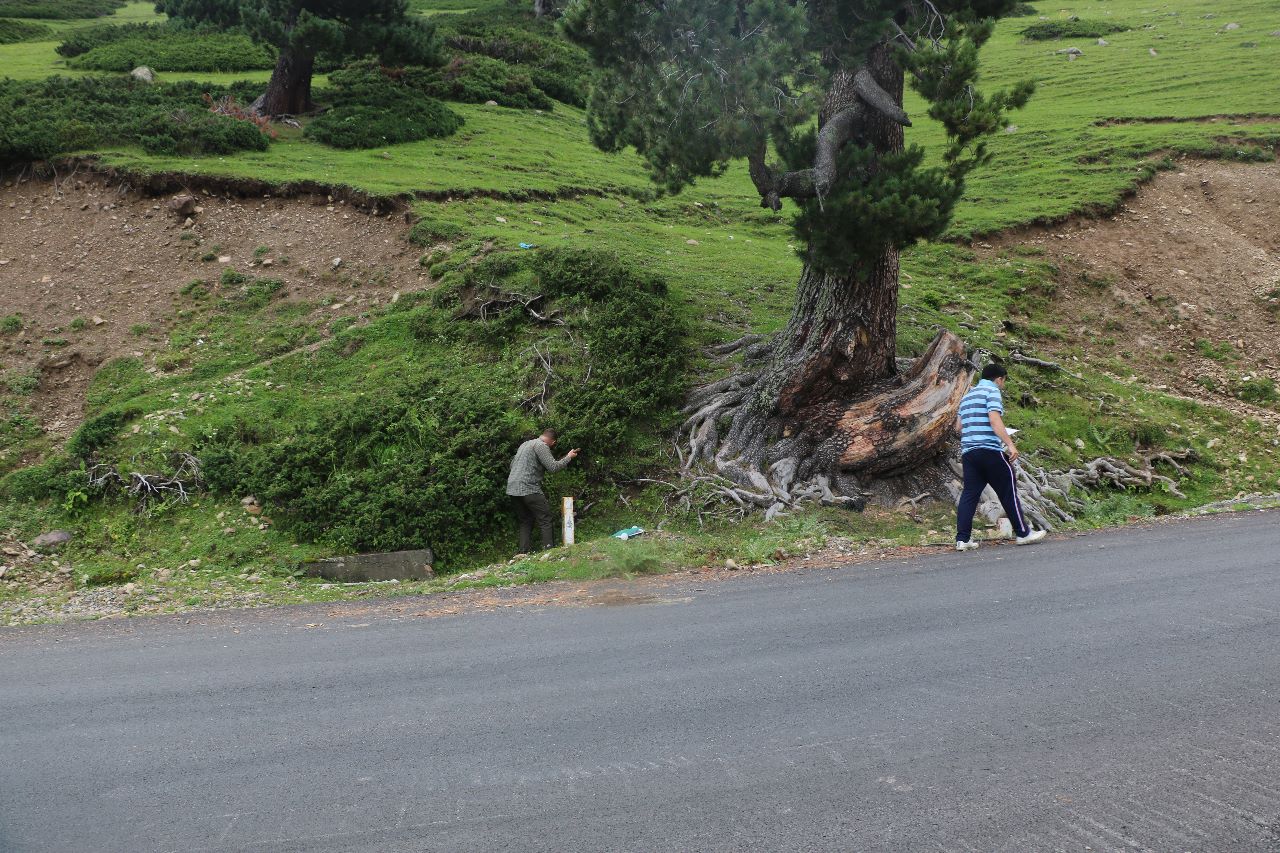- A global study notes consistent increases in the number of alien plant species in mountainscapes and their swift spread into higher elevations between 2007 and 2017.
- In Kashmir Himalayas in India, scientists have noted railway and road infrastructure expansion is a contributing factor to the march of invasive alien plant species higher into the mountains.
- The scientists call for minimising disturbance from construction in these landscapes and continued monitoring to detect and manage potentially problematic species at an early stage.
Botanist Pervaiz Dar spent a good amount of time in 2012 and 2017 squatting and walking along roadsides in Kashmir, including at mountain pass Sinthan Top, surveying invasive alien plant species – plants that do not originally call Kashmir home but are now rapidly spreading into the region and creeping upwards into the mountains driven by expansion of infrastructure.
Surveying these plants in a T-shaped study plot, with the base of the T along the mountain roads and the limb of the T stretching away from them, Dar witnessed a myth unravel. “Mountains are no longer spared from invasive alien species. They are increasing in numbers and frequency over time,” Dar told Mongabay-India.
Field thistles with clusters of purple flowers (Cirsium arvense), mats of white clover (Trifolium repens) and small tumbleweed mustard with bright yellow flowers (Sisymbrium loeselii) are silently creeping up along mountain roads in Kashmir Himalayas in India and expanding their spread. Disturbances in the soil due to construction help alien plants to get to newer habitats.
Dar’s survey is part of a global study by Mountain Invasion Research Network (MIREN) that reveals the spread of invasive alien plant species into higher altitudes has rapidly accelerated along transport routes. Through surveys along mountain roads in southern and central Chile, two regions of Australia, Tenerife in Spain’s Canary Islands, Switzerland, Hawaii and two regions of western USA, Kashmir in India, and Norway, the study shows “consistent increases” in the number of alien plant species and their swift spread into higher elevations between 2007 and 2017.

The findings are based on almost 15,000 observations of 616 non-native plant species from 651 study plots and are collected worldwide using the same standardised procedure. “The number of alien plant species surveyed in each region has increased by a global average of 16% in the past 10 years. In addition, in ten out of the eleven mountain regions studied, the species are occurring at significantly higher elevations than ten or even five years ago,” said first author Evelin Iseli from the Institute of Integrative Biology at ETH Zurich.
“Most non-native plants are promoted by disturbance caused by human activities. In mountainous areas, roads provide access points and conduits for spread, with the result that many nonnative plants can be found in disturbed roadside habitat. Roads also provide very convenient ways to sample a range of elevation zones,” Iseli explained.
Roads provide “early warning” for species which might later establish in more natural habitat and might therefore be valuable to predict possible emerging threats to native species and ecosystems, they say.
However, the researchers caution against attributing the trend documented in the survey to climate change because even without global warming alien plants manage to settle into spots that match their climatic preferences. Alien plants, usually introduced in the lowlands, spread to higher elevations until it becomes too cold for them to reproduce, Iseli said.
But climate warming will “almost certainly” increase the suitability of higher-elevation regions for many nonnative plants, and so promote further expansion, they warn.
Iseli and colleagues want to see continued monitoring to identify and manage potentially problematic species at an early stage. They advise against planting of non-native plants (e.g. ornamental or commercial species) at high elevation, especially those originating from cooler climates in other parts of the world and call for expanding monitoring studies with research on the impact of potentially problematic species on the native vegetation.
Global goals to address alien species and regional biosecurity disparities
Ecosystem specialist Srijana Joshi Rijal at International Centre for Integrated Mountain Development echoes Iseli on setting up early detection and rapid response systems. She says citizens could be engaged in monitoring invasive alien species.
“The research is valuable and underscores the value and need for such long-term studies to understand the trend in mountain regions that we currently lack in the Hindu Kush Himalayan region,” Joshi Rijal, who was not associated with the global study, told Mongabay-India.
Invasive species management will be an expensive and challenging task once the species spreads into a topographically complex mountain ecosystem. “In-depth research is needed to address invasions into mountain ecosystems, including the analysis of multiscale invasion patterns in mountain regions, and comparative research across regions on how invasive species interact in mountain environments,” she says.
About 50% of invasive plants in the Hindu Kush Himalaya (HKH) region have been introduced unintentionally. Largely, countries in the Hindu Kush Himalayan region lack policies and legislation to tackle invasive alien species because it is not a priority conservation issue, Joshi Rijal notes.
For example, India lacks a specific legislative framework to deal with invasive species, even while having a long history of environmental policies. The Wildlife (Protection) Amendment Bill 2021 introduced a regulatory framework for ‘invasive alien species’ in the Indian environmental legislative regime, which is still in infancy, points out study co-author Irfan Rashid, one of the three MIREN scientists from the Kashmir Himalayas in India.

Pervaiz Dar believes a rethink of classification of invasive species is also required because certain species that are native to some states in India can be invasive in other parts of the country.
According to Vidhi Centre for Legal Policy, an independent think-tank doing legal research to improve laws, the scope of the WPA amendment is narrow. The Bill defines IAS as a species of animal or plant which is not native to India and whose introduction or spread may threaten or adversely impact wildlife or its habitat. But the Convention on Biological Diversity, defines an ‘alien species’ in the context of its natural location. So species which are native to India, but are still invasive when introduced to a new habitat within the country, remain outside the purview of regulation.
A 2019 report by the Intergovernmental Science-Policy Platform on Biodiversity and Ecosystem Services (IPBES), an independent science and policy group, identifies invasive alien species as one of the five direct drivers of change in nature with the largest relative global impacts.
In its 23 global targets for 2030, the Kunming-Montreal Global Biodiversity Framework adopted by 15th Conference of Parties (COP15) to the UN Convention on Biological Diversity, calls for countries to identify and manage pathways of introduction of alien species, prevent the introduction of priority IAS, and reduce by at least half the introduction and establishment of other known or potential IAS, and eradicate or control IAS on islands and other priority sites.
The new ambition on identifying and managing pathways of introduction of alien species embedded in the Framework signals countries to ramp environmental biosecurity. But Joshi Rijal points out that not all countries, especially in the HKH region are equally placed to have such strong biosecurity to defend against invasion.
“China, for example, is advanced in its biosecurity. Open borders with other countries are more susceptible to invasion. But, we have open borders among countries in the HKH region, for example with India and Nepal, for which international cooperation is needed in biosecurity,” Joshi Rijal said.
Garden flowers to pines and daisies
Long term-data gathered by the MIREN study shows that lupines, a popular garden flower, are a species of concern in Switzerland. Originally from the Pacific Northwest region of America, it was introduced in Germany 170 years ago and has been found in Switzerland for about 70 years.
In South America, woody species like pines are problematic in native mountain forests; in Kashmir the field thistle is an important invasive species which has also been recorded in the survey and in Australia, the sweet vernal grass is the first common invasive species to reach the alpine area during the study, also proving to be the most likely species to leave the roadside and spread into natural vegetation, explains Iseli.
Invasive daisies such as the ox-eye daisy were detected in several of the regions surveyed in the study, including in the Kashmir Himalayas.
Believed to have been introduced by the British in pre-Independence India for its showy flowers, ox-eye daisies that adorned ornate gardens in Kashmir rapidly spilled out and effortlessly invaded the region’s fragile forest and mountain landscapes over time.
Read more: Snug in Kashmir’s meadows, ox-eye daisy worries scientists
“Most of these introductions are unintentional. Roads are giving safe passage to these species,” says Irfan Rashid at University of Kashmir, where 17% of the alien species are reported to be invasive.

In Kashmir, Rashid and colleagues discovered a small net loss of non-native species over time, as compared to other regions during the MIREN surveys. Minimising soil disturbance during infrastructure expansion is one way to mitigate the challenges with invasive alien species.
“In our global study the Himalayas is represented by Kashmir Himalayas; we need more transects across other Himalayan regions including the central and eastern parts of the Indian Himalayan region to substantiate our results. We are looking for more collaboration from other parts of the IHR to set up more MIREN transects,” added Rashid.
Long-term impacts of infrastructure expansion into mountainscapes also extends to the railways. In Kashmir, Rashid and colleagues found a single disturbance event associated with railway construction had large and long-lasting effects on plant communities- driving their spread to higher elevations.
“However, the impacts of these invasive species have rarely been evaluated. Every species is unique, and we cannot label all the invasive species as bad plants; as they are relatively bad,” noted Rashid who along with MIREN colleagues is carrying out impact studies of some of the invasive species in Kashmir, such as field thistle (Cirsium arvense), a troublesome and persistent weed, native to Europe and the eastern Mediterranean area, that was introduced into Kashmir more than a century ago by the British.
ICIMOD’s Srijana Joshi Rijal concurs. She reiterates that most research is focused on distribution and spread of invasive species, whereas “other thematic topics such as control and management and impact are less studied in the region.”
“We need to put more emphasis and allocate dedicated resources for the management of the IAS which has not materialized. It could be due to the lack of adequate evidence, especially the valuation of economic loss from IAS in different countries,” she added.
A recent analysis points to glaring knowledge gaps in costs incurred by IAS species to the Indian economy. India has lost $127.3 billion (Rs. 8.3 trillion) in the last 60 years to invasive alien species, making the South Asian nation the second most invasion-cost bearing country after the United States, but this figure reflects the costs incurred only for 3% of the known invasive species, researchers said in the analysis.
Read More: The cost of invasive species bears heavy on Indian economy, finds study
Evolutionary biologist Alok Bang and lead author of that analysis, says the lack of search terms for “invasive species”, “biological invasions” or common names of invasive species in regional languages, impedes search for relevant cost sources. “It is also necessary to have information on native species so that even within the country, there is no homogenisation of biodiversity. Each region within India (and any country) has its own flora and fauna so a regional framework to address IAS is also crucial,” Bang told Mongabay-India.
Banner image: An ETH Zurich researcher is looking for alien plant species along a mountain road in Wallis, Switzerland. Photo by Fiona Schwaller/ETH Zurich.
